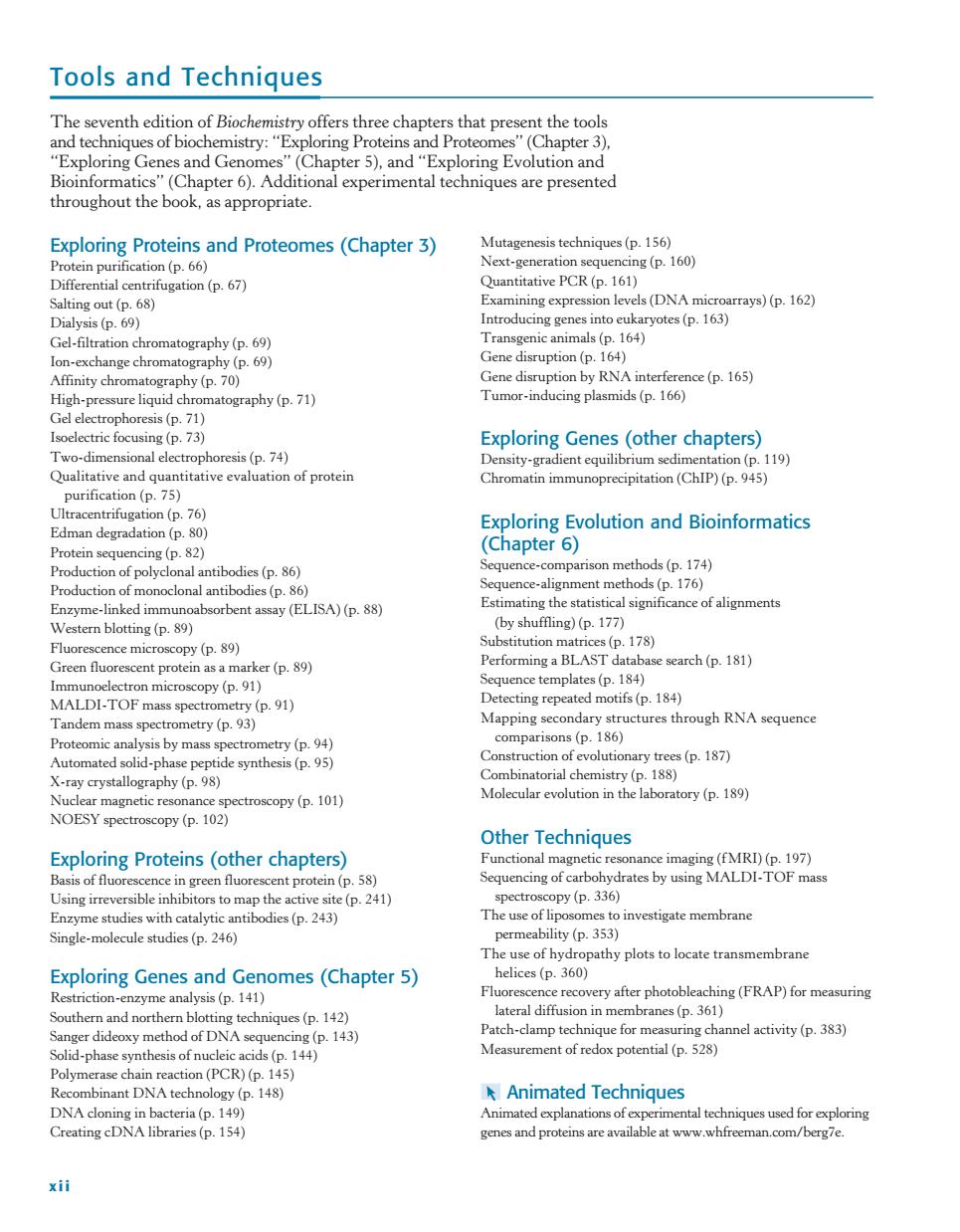正在加载图片...

Tools and Techniques The seventh edition of Biochemistry offers three chapters that present the tools and techniques of biochemistry:"Exploring Proteins and Proteomes"(Chapter 3), "Exploring Genes and Genomes"(Chapter 5),and"Exploring Evolution and Bioinformatics"(Chapter 6).Additional experimental techniques are presented throughout the book,as appropriate. Exploring Proteins and Proteomes (Chapter 3) Mutagenesis techniques(p.156) Protein purification(p.66) Next-generation sequencing(p.160) Differential centrifugation(p.67) Quantitative PCR(p.161) Salting out(p.68) Examining expression levels(DNA microarrays)(p.162) Dialysis (p.69) Introducing genes into eukaryotes(p.163) Gel-filtration chromatography(p.69) Transgenic animals(p.164) Ion-exchange chromatography(p.69) Gene disruption(p.164) Affinity chromatography (p.70) Gene disruption by RNA interference(p.165) High-pressure liquid chromatography(p.71) Tumor-inducing plasmids(p.166) Gel electrophoresis(p.71) Isoelectric focusing(p.73) Exploring Genes (other chapters) Two-dimensional electrophoresis(p.74) Density-gradient equilibrium sedimentation(p.119) Qualitative and quantitative evaluation of protein Chromatin immunoprecipitation(ChIP)(p.945) purification(p.75) Ultracentrifugation(p.76) Edman degradation(p.80) Exploring Evolution and Bioinformatics Protein sequencing(p.82) (Chapter 6) Production of polyclonal antibodies(p.86) Sequence-comparison methods(p.174) Production of monoclonal antibodies (p.86) Sequence-alignment methods(p.176) Enzyme-linked immunoabsorbent assay(ELISA)(p.88) Estimating the statistical significance of alignments Western blotting(p.89) (by shuffling)(p.177) Fluorescence microscopy(p.89) Substitution matrices(p.178) Green fluorescent protein as a marker(p.89) Performing a BLAST database search(p.181) Immunoelectron microscopy(p.91) Sequence templates(p.184) MALDI-TOF mass spectrometry (p.91) Detecting repeated motifs(p.184) Tandem mass spectrometry(p.93) Mapping secondary structures through RNA sequence Proteomic analysis by mass spectrometry(p.94) comparisons(p.186) Automated solid-phase peptide synthesis(p.95) Construction of evolutionary trees(p.187) X-ray crystallography(p.98) Combinatorial chemistry(p.188) Nuclear magnetic resonance spectroscopy(p.101) Molecular evolution in the laboratory (p.189) NOESY spectroscopy(p.102) Other Techniques Exploring Proteins (other chapters) Functional magnetic resonance imaging(fMRI)(p.197) Basis of fluorescence in green fluorescent protein(p.58) Sequencing of carbohydrates by using MALDI-TOF mass Using irreversible inhibitors to map the active site(p.241) spectroscopy(p.336) Enzyme studies with catalytic antibodies(p.243) The use of liposomes to investigate membrane Single-molecule studies(p.246) permeability(p.353) The use of hydropathy plots to locate transmembrane Exploring Genes and Genomes (Chapter 5) helices(p.360) Restriction-enzyme analysis(p.141) Fluorescence recovery after photobleaching(FRAP)for measuring Southern and northern blotting techniques(p.142) lateral diffusion in membranes(p.361) Sanger dideoxy method of DNA sequencing(p.143) Patch-clamp technique for measuring channel activity(p.383) Solid-phase synthesis of nucleic acids(p.144) Measurement of redox potential(p.528) Polymerase chain reaction(PCR)(p.145) Recombinant DNA technology(p.148) kAnimated Techniques DNA cloning in bacteria(p.149) Animated explanations of experimental techniques used for exploring Creating cDNA libraries(p.154) genes and proteins are available at www.whfreeman.com/berg7e. xiixii Exploring Proteins and Proteomes (Chapter 3) Protein purification (p. 66) Differential centrifugation (p. 67) Salting out (p. 68) Dialysis (p. 69) Gel-filtration chromatography (p. 69) Ion-exchange chromatography (p. 69) Affinity chromatography (p. 70) High-pressure liquid chromatography (p. 71) Gel electrophoresis (p. 71) Isoelectric focusing (p. 73) Two-dimensional electrophoresis (p. 74) Qualitative and quantitative evaluation of protein purification (p. 75) Ultracentrifugation (p. 76) Edman degradation (p. 80) Protein sequencing (p. 82) Production of polyclonal antibodies (p. 86) Production of monoclonal antibodies (p. 86) Enzyme-linked immunoabsorbent assay (ELISA) (p. 88) Western blotting (p. 89) Fluorescence microscopy (p. 89) Green fluorescent protein as a marker (p. 89) Immunoelectron microscopy (p. 91) MALDI-TOF mass spectrometry (p. 91) Tandem mass spectrometry (p. 93) Proteomic analysis by mass spectrometry (p. 94) Automated solid-phase peptide synthesis (p. 95) X-ray crystallography (p. 98) Nuclear magnetic resonance spectroscopy (p. 101) NOESY spectroscopy (p. 102) Exploring Proteins (other chapters) Basis of fluorescence in green fluorescent protein (p. 58) Using irreversible inhibitors to map the active site (p. 241) Enzyme studies with catalytic antibodies (p. 243) Single-molecule studies (p. 246) Exploring Genes and Genomes (Chapter 5) Restriction-enzyme analysis (p. 141) Southern and northern blotting techniques (p. 142) Sanger dideoxy method of DNA sequencing (p. 143) Solid-phase synthesis of nucleic acids (p. 144) Polymerase chain reaction (PCR) (p. 145) Recombinant DNA technology (p. 148) DNA cloning in bacteria (p. 149) Creating cDNA libraries (p. 154) Mutagenesis techniques (p. 156) Next-generation sequencing (p. 160) Quantitative PCR (p. 161) Examining expression levels (DNA microarrays) (p. 162) Introducing genes into eukaryotes (p. 163) Transgenic animals (p. 164) Gene disruption (p. 164) Gene disruption by RNA interference (p. 165) Tumor-inducing plasmids (p. 166) Exploring Genes (other chapters) Density-gradient equilibrium sedimentation (p. 119) Chromatin immunoprecipitation (ChIP) (p. 945) Exploring Evolution and Bioinformatics (Chapter 6) Sequence-comparison methods (p. 174) Sequence-alignment methods (p. 176) Estimating the statistical significance of alignments (by shuffling) (p. 177) Substitution matrices (p. 178) Performing a BLAST database search (p. 181) Sequence templates (p. 184) Detecting repeated motifs (p. 184) Mapping secondary structures through RNA sequence comparisons (p. 186) Construction of evolutionary trees (p. 187) Combinatorial chemistry (p. 188) Molecular evolution in the laboratory (p. 189) Other Techniques Functional magnetic resonance imaging (fMRI) (p. 197) Sequencing of carbohydrates by using MALDI-TOF mass spectroscopy (p. 336) The use of liposomes to investigate membrane permeability (p. 353) The use of hydropathy plots to locate transmembrane helices (p. 360) Fluorescence recovery after photobleaching (FRAP) for measuring lateral diffusion in membranes (p. 361) Patch-clamp technique for measuring channel activity (p. 383) Measurement of redox potential (p. 528) Animated Techniques Animated explanations of experimental techniques used for exploring genes and proteins are available at www.whfreeman.com/berg7e. The seventh edition of Biochemistry offers three chapters that present the tools and techniques of biochemistry: “Exploring Proteins and Proteomes” (Chapter 3), “Exploring Genes and Genomes” (Chapter 5), and “Exploring Evolution and Bioinformatics” (Chapter 6). Additional experimental techniques are presented throughout the book, as appropriate. Tools and Techniques